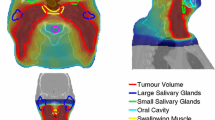Abstract
Mixed integer programming models and computational strategies developed for treatment planning optimization in brachytherapy are described. The problem involves the designation of optimal placement of radioactive sources (seeds) inside a tumor site. Two MIP models are described. The resulting MIP instances are difficult to solve, due in large part to dense constraint matrices with large disparities in the magnitudes of the nonzero entries. A matrix reduction and approximation scheme is presented as a computational strategy for dealing with the dense matrices. Penalty-based primal heuristic and branching strategies to assist in the solution process are also described. Numerical results are presented for 20 MIP instances associated with prostate cancer cases. Compared to currently used computer-aided planning methods, plans derived via the MIP approach use fewer seeds (20–30 fewer) and needles, and provide better coverage and conformity – measures commonly used to assess the quality of treatment plans. Good treatment plans are returned in 15 CPU minutes, suggesting that incorporation of this MIP-based optimization module into a real-time comprehensive treatment planning system is feasible.
Similar content being viewed by others
References
G.K. Bahr, J.G. Kereiakes, H. Horwitz, R. Finney, J. Galvin and K. Goode, The method of linear programming applied to radiation treatment planning, Radiology 91 (1968) 686–693.
R.E. Bixby, S. Ceria, C.M. McZeal and M.W.P. Savelsbergh, An Updated Mixed Integer Programming Library: MIPLIB 3 (1998).
R.E. Bixby and E.K. Lee, Solving a truck dispatching scheduling problem sing branch-and-cut, Ph.D. Thesis, Department of Computational and Applied Mathematics, Rice Univerity, Houston, TX (1993). Companion paper appeared in Operations Research 46(3) (1998) 355–367.
R.J. Gallagher and E.K. Lee, Mixed integer programming optimization models for brachytherapy treatment planning, Journal of the American Medical Informatics Association, Symposium Supplement, ed. D.R. Masys (1997) 278–282.
Interstitial Collaborative Working Group, Interstitial Brachytherapy: Physical, Biological, and Clinical Considerations (Raven Press, New York, 1990).
M. Langer, R. Brown, M. Urie, J. Leong, M. Stracher and J. Shapiro, Large scale optimization of beam weights under dose-volume restrictions, International Journal of Radiation Oncology and Biological Physics 18 (1990) 887–893.
E.K. Lee, Computational experience of a general purpose mixed 0/1 integer programming solver (MIPSOL), Technical Report, Georgia Institute of Technology (1997).
E.K. Lee, R.J. Gallagher, D. Silvern, C.S. Wuu and M. Zaider, Treatment planning for brachytherapy: an integer programming model, two computational approaches and experiments with permanent prostate implant planning, Physics in Medicine and Biology 44(1) (1999) 145–165.
E.K. Lee, E.L. Johnson and G.L. Nemhauser, Matrix reduction techniques for dense MIPs, Working paper.
E.K. Lee and M. Zaider, Analysis of the use of different clinical objectives in the design of treatment plans for brachytherapy, Working paper.
J. Legras, B. Legras and J.-P. Lambert, Software for linear and nonlinear optimization in external radiotherapy, Comput. Prog. Biomed. 15 (1982) 233–242.
I.I. Rosen, R.G. Lane, S. Morrill and J.A. Belli, Treatment plan optimization using linear programming, Phys. Med. Biol. 18 (1991) 141–152.
M.W.P. Savelsbergh, Preprocessing and probing for mixed integer programming problems, ORSA Journal on Computing 6 (1994) 445–454.
D.A. Silvern, Automated OR prostate brachytherapy treatment planning using genetic optimization, Ph.D. Thesis, Department of Applied Physics, Columbia University, New York (1998).
D.A. Silvern, E.K. Lee, R.J. Gallagher, L.G. Stabile, R.D. Ennis, C.R. Moorthy and M. Zaider, Treatment planning for permanent prostate implants: genetic algorithm versus integer programming, Medical & Biological Engineering & Computing, Supplement 35, Part 2 (1997) 850.
R.S. Sloboda, Optimization of brachytherapy dose distributions by simulated annealing, Medical Physics 19 (1992) 955–964.
C.S. Wuu, R.D. Ennis, P.B. Schiff, E.K. Lee and M. Zaider, Dosimetric criteria for selecting a source activity and a source type (125I or 103Pd) in the presence of irregular pellet placement in permanent prostate implants, International Journal of Radiation Oncology, Biology and Physics 47 (2000) 815–820.
Y. Yu and M.C. Schell, A genetic algorithm for optimization of prostate implants, Medical Physics 23 (1996) 2085–1091.
Author information
Authors and Affiliations
Corresponding author
Rights and permissions
About this article
Cite this article
Lee, E.K., Zaider, M. Mixed Integer Programming Approaches to Treatment Planning for Brachytherapy – Application to Permanent Prostate Implants. Annals of Operations Research 119, 147–163 (2003). https://doi.org/10.1023/A:1022986523863
Issue Date:
DOI: https://doi.org/10.1023/A:1022986523863




